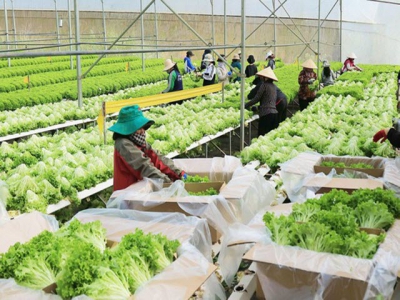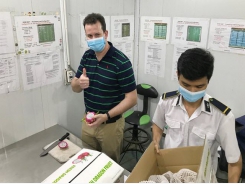Agricultural sector needs impulse for sustainable development

Despite many achievements, the agricultural investment and development in the Central and Central Highlands of Vietnam are facing many challenges due to a shortage of capital, unstable prices, or a lack of market for products. Enterprises and farmers are looking forward to the third dialogue conference between Prime Minister Nguyen Xuan Phuc and farmers scheduled to take place on September 28 in Buon Ma Thuot City in Dak Lak Province, with the hope that it will open the tie-knot and promote sustainable agricultural production development.
High-tech agricultural production helps farmers get rich in Lam Dong Province. (Photo: SGGP)
For many years, the production of key agricultural products in the Central Highlands, such as coffee, black pepper, rubber, vegetables, and flowers, has achieved remarkable results. In Lam Dong Province, there are about 54,000 hectares for hi-tech agricultural production with an average turnover of over VND160 million per hectare and an average income of VND400-500 million per hectare per year for farmers. Of which, coffee farmers get about VND200 million per hectare year, and flower growers earn from VND800 million to VND1.2 billion per hectare per year. Meanwhile, in Gia Lai Province, with the participation of many "big fish" in the agricultural sector, the province has initially developed crops with high economic value, associated with building brands and trademarks for products. In the province, there are about 1,262 hectares of vegetables, fruits, and coffee, that have certified for safe production under the VietGAP, GlobalGAP, and organic standards. In the period from 2016 to 2020, the province has had 15 hi-tech agricultural projects with a total registered capital of VND2.37 trillion, and at the same time, has approved for 26 investors to research and survey projects with a total registered capital of more than VND4.25 trillion.
Down to the Central provinces, during these days, farmers in Quang Tri Province are enjoying a bumper summer-autumn rice crop with high paddy prices. Of which, the organic rice production model gives an average yield of 6.6-7 tons per hectare or even 8 tons per hectare at some places. Paddy is bought at VND10,000 per kilogram in the field, and the net profit is more than VND20 million per hectare compared to conventional rice production. This is also the 10th crop since farmers in Quang Tri Province participated in the organic rice production following the natural farming process in which all products are committed to consumption. Mr. Ha Sy Dong, Vice Chairman of the People's Committee of Quang Tri Province, said that the organic rice production model gives a stable output. The prices of paddy are 1.5-2 times higher than those of conventional rice production, so now farmers are willing to grow organic rice. Specially, after the information that Quang Tri’s organic rice contains Momilactone A and Momilactone B - the two precious compounds with anti-diabetes and anti-obesity effects - was widely publicized, the sales of Quang Tri’s organic rice have tripled compared to before. At the same time, Quang Tri’s organic rice has entered major supermarkets across the country and participated in commercial stalls in some countries.
Besides upsides, agricultural production in the Central and the Central Highlands still faces many difficulties, in which the situation of “good harvest and bad price” has not ended yet. Mr. Pham Van Chu, a farmer in Ea Nam Commune in Ea H’leo District in Dak Lak Province, has 6 hectares of coffee trees. Previously, the price of coffee was high, so his family was well-off. Now, the price of coffee beans has decreased to just above VND32,000 per kilogram, so it is not enough to cover production costs. He and some other farmers destroyed a part of their coffee trees to switch to grow fruit trees, but the prices of fruits also dropped, leading to losses. Currently, he does not know what types of trees to grow to make a profit.
Another difficulty is the consumer market problem. Ms. Luong Thi Oanh, Director of Ea Wy Agricultural Production Cooperative in Ea Wy Commune in Ea H'leo District in Dak Lak Province, said that the cooperative has 105 members participating in the production of 100 hectares of organic coffee trees under the VietGAP standards. However, because there is no consumer market, the cooperative does not dare to expand the growing area though the land bank remains available.
Meanwhile, Mr. Hoang Phuoc Binh, Vice Chairman of the Chu Se Pepper Association in Gia Lai Province, said that the field survey in six key pepper-growing provinces in the country, of which three provinces in the Central Highlands are Dak Lak, Dak Nong, and Gia Lai. By the dry season of this year, the area of pepper plants has decreased sharply compared to its peak in 2017. Because the price of pepper was extremely low, so farmers forsook their pepper plants. Another problem is that there should be cooperation and association in pepper production between farmers and farmers and between farmers and enterprises, but the linkage has not been done well, leading to the low efficiency of pepper. When the price of pepper falls, both farmers and enterprises are in trouble.
According to Mr. Le Van Cuong, Director of Dalat G.A.P Company Limited in Da Lat City, as for vegetable products, if an enterprise wants to export vegetables, it must cultivate vegetables on a large scale, meeting a large number of orders and continuity. To do that, it requires high-tech agricultural production, but the biggest difficulty is the financial crunch. Because the land and assets on the land are worth billions of Vietnamese dong, but they are not guaranteed to be collaterals. Therefore, farmers can only mobilize capital from family members by themselves.
Dr. Truong Hong, former Director of the Western Highlands Agro-Forestry Scientific and Technical Institute, said that Vietnam's agricultural production in general, especially key crops in the Central Highlands, is facing many difficulties, particularly the problem about price and market. Producers only pay attention to expanding the growing area and high productivity but do not interested in the added-value of their products. The agricultural sector already has a production plan but has not had a market plan yet. The absence of the market, along with overproduction, has changed the balance of supply and demand, leading to low prices of agricultural products. Moreover, the organization of production is not compatible with the trend of international integration. Agricultural production is on a small scale. Each farming household applies techniques differently on their crops, leading to a difference in quality. When trading large batches of agricultural products for export, the quality will not be the same, and the partners will find it difficult to accept, especially in fastidious markets like Europe.
Mr. Nguyen Ngoc Sam, Secretary of the Party Committee of Sa Thay District in Kon Tum Province, said that the main crop of the province is rubber. At the same time, the province is currently developing fruit trees. Recent climate change has depleted water resources in some places. Therefore, the province hopes that the Government will have policies to renovate lakes and dams to ensure water resources for agricultural development.
Mr. Y Giang Gry Niê, Vice Chairman of the People's Committee of Dak Lak Province, said that despite the strength of fertile soil and favorable climate, the province also has to cope with many obstacles, such as necessary infrastructure has not been synchronized; there is no investment in deep processing industrial factories for agriculture; farmers lack economic resources. Dak Lak Province also hopes that the Prime Minister and the Government will continue to pay attention to investing in infrastructure, building roads to connect the region, attracting investment, improving product value, and promoting sustainable agricultural development.
Related news
Tools

Phối trộn thức ăn chăn nuôi

Pha dung dịch thủy canh

Định mức cho tôm ăn

Phối trộn phân bón NPK

Xác định tỷ lệ tôm sống

Chuyển đổi đơn vị phân bón

Xác định công suất sục khí

Chuyển đổi đơn vị tôm

Tính diện tích nhà kính

Tính thể tích ao




 Opportunities await sugarcane farmers if they change their…
Opportunities await sugarcane farmers if they change their…  Vietnam’s Jan-Sept coffee exports drop 1.4%, rice down…
Vietnam’s Jan-Sept coffee exports drop 1.4%, rice down…